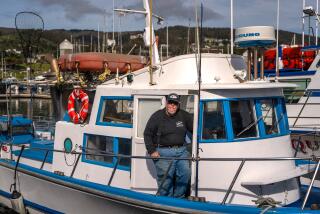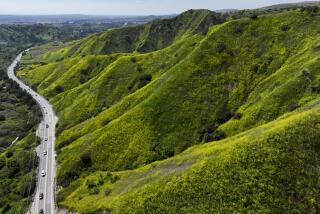Nature May Suffer Most in State’s Long Drought : Environment: The four-year dry spell has exacted a heavy toll on forests, rivers and wildlife.
- Share via
SACRAMENTO — California’s drought has taken a massive environmental toll in dead trees and wildfires, in devastated salmon and striped bass runs, and in deer lost to a bacterial disease that thrives in shrinking watering holes, state officials said Monday.
While cities have gotten by through conservation efforts and farmers are making do by pumping ground water, officials have been surprised by the drought’s toll in forests and rivers.
“We are just beginning to see the most dramatic impacts of the drought,” said Dick Daniel, assistant chief of the state Department of Fish and Game’s environmental services division.
The damage to fisheries is a result of the reduction of flow from mountain reservoirs into the Sacramento-San Joaquin River Delta, the huge estuary where the state and U.S. governments divvy up water for their aqueducts. The delta is inland from San Francisco Bay.
When too little water is released from the dams, the river water becomes too warm for salmon to spawn. Under a special arrangement, cold deep water will be released from Shasta Dam in an effort to save 484 salmon known to have survived the winter run up the Sacramento River--the last of what once was a historic spawning run. But there is no cold water available for other rivers.
“On the American River this year we are expecting near-total loss of the fall-run Chinook salmon,” Daniel said.
When the water temperature reached an extreme high of 78 degrees in a hatchery on the American River last week, more than 3,000 pounds of trout were lost and a like amount released into the river in an effort to save them, Daniel said.
An attempt will be made to rescue some fish from the American, San Joaquin and Stanislaus rivers later this summer. If they survive the tricky procedure of being trapped, transported to a hatchery and artificially spawned, their eggs will be replanted in the river when the water temperature drops in fall.
Striped bass, popular game fish that breed in the delta, are more plentiful than salmon, but officials are alarmed because the stripers are being found in their lowest numbers ever.
“We don’t know if the striped bass will recover,” Daniel said.
Deer are dying from the spread of blue tongue disease, which is caused by bacteria that build up in shrinking watering holes. Exact numbers for the deer loss are not known, he said, but hunters are finding carcasses and a scarcity of deer in the Coast Range and the Sierra Nevada.
Deer also have suffered from a loss of acorns, a favorite food. The poor health of does has led to fewer fawns surviving this year, Daniel said.
Scarcity of food in the wilds also has brought a rash of mountain lion reports in settled areas--a lion believed to have traveled from Fresno County was trapped in a yard last week in Rancho Cordova, a Sacramento suburb--and led to dozens of clashes between bears and humans.
“The number of incidents with bears has gone way up,” Daniel said.
Drought is nothing new to California wildlife, officials stress. If a species evolved here, it did so through periodic cycles of dry weather--the last comparable one lasting six years from 1929 to 1934. But this drought is different because the state now has about 29 million residents who have a claim on the available water. Many also live in suburbs and towns built on what were recently wildlands where deer and mountain lions ranged, Daniel said.
With more people living in the hills, the fire danger to homes has also increased since previous droughts.
The fire toll for the year stands at 304,900 acres burned and 873 structures destroyed. Three firefighters have died. It has been the state’s worst fire year since 1987--the worst in history--when 11 firefighters were killed and 740,000 acres scorched.
Foresters estimate that the trees--mostly firs and pines--killed by the bark beetles that thrive in drought hold the equivalent of 12 billion board feet of lumber. That is more wood than California normally uses for construction in a year, said Karen Terrill, spokeswoman for the state Department of Forestry and Fire Protection.
Millions of trees are affected. Brown trees are especially visible at lower elevations in the southern half of the Sierra Nevada, where the climate has been driest, and in the Tahoe National Forest. “It’s almost 50-50 (between live and dead trees) in parts of that forest,” Terrill said.
Tropical storms in May and June removed 1990 from the list of epic dry years. Nonetheless, this will be the 12th-driest year this century for California’s milestone water basin--the Sacramento River Basin--and an even more historic dry period in areas such as Santa Barbara, where one of two municipal reservoirs has gone dry.
Even as state officials were tallying the ravages of the four-year drought, they also were turning to historical records to predict that the dry spell will probably not continue.
“The historical odds are 9 in 10 that there will be more runoff next year,” said Maurice Roos, chief hydrologist for the state Department of Water Resources.
Virtually the same odds were held for last winter when, nonetheless, the state’s rain and snowfall were below normal for the fourth year, the longest dry stretch since the 1930s.
More to Read
Sign up for Essential California
The most important California stories and recommendations in your inbox every morning.
You may occasionally receive promotional content from the Los Angeles Times.










